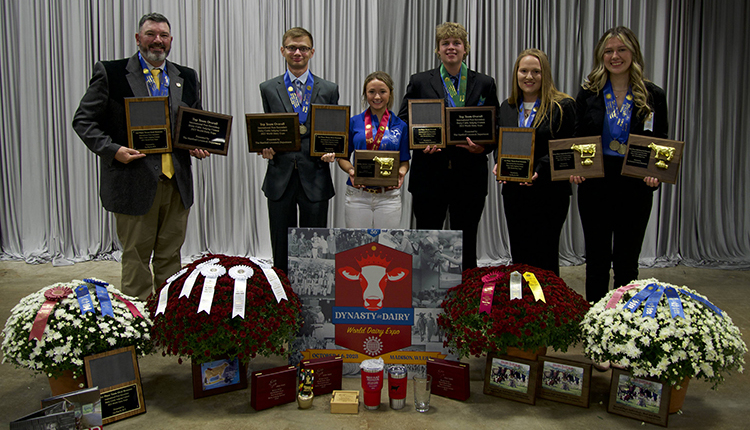Last week's Cooperative Network Dairy Directors and Leadership Conference slides are now posted. We did mention the Minneapolis Federal Reserve bank's economic outlook last week.
Specifically on dairy, if you read and analyzed every slide from every presentation, you should have a good idea of the current state of the U.S. dairy industry, and what might be coming down the pipeline.
A twist on current proposals

Two presentations that made an impact were those by Associated Milk Producers, Inc., (AMPI) and the Midwest Dairy Coalition (MDC). It should be noted that AMPI is a member of MDC, but MDC answers to six other cooperatives including Bongards' Creameries, Family Dairies USA, First District Association (FDA), Manitowoc Milk Producers Association, Mid-West Dairymen's Company, and the Milwaukee Cooperative Milk Producers. You will notice that Bongards', Family Dairies USA, and Milwaukee Co-op are not NMPF members. The MDC also has two non-dairy co-op members in Cooperative Network and the Wisconsin Department of Agriculture, Trade and Consumer Protection.
AMPI's presentation was given by CEO Ed Welch. He explained that when he served on the Dairy Industry Advisory Committee (DIAC), the goal was to, "Construct dairy policies that support family farms, not milk volume." While AMPI agrees to explore elimination of the Dairy Product Price Support Program (as does just about everyone), it disagreed that an insurance program paired with an intermittent growth management program was the sole answer.
Instead, they would rather modify the current Milk Income Loss Contract (MILC) program and provide insurance as an option. The argument is that under MILC more herds are covered because there is a cap on spending.
Steve Etka of Midwest Dairy Coalition, said that a hybrid program was a possibility, including one like DIAC Recommendation number 11:
"Continue MILC, with a production cap based on available funds, with two milk - important modifications: (1) use an all income/feed cost margin trigger, and (2) provide an insurance program for production excluded by the cap to provide protection for larger producers."
 He also explained that he saw the DIAC as more representative of Congress than the National Milk Producers Federation. Etka argued that the DIAC backgrounds are more diverse and the geographies are varied. He also pointed out that budget hawks will also look for caps.
He also explained that he saw the DIAC as more representative of Congress than the National Milk Producers Federation. Etka argued that the DIAC backgrounds are more diverse and the geographies are varied. He also pointed out that budget hawks will also look for caps.
Showing the disparity of MILC versus the proposed insurance program, an MDC slide states:
If NMPF Margin Program (at the base level) had been in place instead of MILC for 2002 through 2009, a 100-cow herd farm would have received $59,000 less in assistance. A 1,000-cow herd farm would have gained $159,000 assistance. While a 10,000-cow herd farm would have gained $2.665 million. Those numbers are nothing to sneeze at, especially if you are a farmer at the 100-cow level.
Order reform still hazy
The Midwest Dairy Coalition also said that the Federal Milk Marketing Order reform package is not ready for prime time. When two members from academia in the audience were asked what they thought about the order reform piece, the agreed with the DIAC that it was not ready.
But despite all the discussion, the Cooperative Network members in attendance unanimously agreed that the principles of Foundation for the Future should still be the starting point for future discussions.
In the meantime, everyone is waiting for the Congressional Budget Office's score (estimated cost) of the NMPF Foundation for the Future plan. Only once those results, and the exact legislation, are revealed can organizations continue to move forward. And even after that, unless the NMPF plan results in budget savings, the odds of a "standalone" dairy bill are slim. However, Bernie Sanders helped stick the Dairy Economic Loss Assistance Payment Program in Fall 2009.
Specifically on dairy, if you read and analyzed every slide from every presentation, you should have a good idea of the current state of the U.S. dairy industry, and what might be coming down the pipeline.
A twist on current proposals

Two presentations that made an impact were those by Associated Milk Producers, Inc., (AMPI) and the Midwest Dairy Coalition (MDC). It should be noted that AMPI is a member of MDC, but MDC answers to six other cooperatives including Bongards' Creameries, Family Dairies USA, First District Association (FDA), Manitowoc Milk Producers Association, Mid-West Dairymen's Company, and the Milwaukee Cooperative Milk Producers. You will notice that Bongards', Family Dairies USA, and Milwaukee Co-op are not NMPF members. The MDC also has two non-dairy co-op members in Cooperative Network and the Wisconsin Department of Agriculture, Trade and Consumer Protection.
AMPI's presentation was given by CEO Ed Welch. He explained that when he served on the Dairy Industry Advisory Committee (DIAC), the goal was to, "Construct dairy policies that support family farms, not milk volume." While AMPI agrees to explore elimination of the Dairy Product Price Support Program (as does just about everyone), it disagreed that an insurance program paired with an intermittent growth management program was the sole answer.
Instead, they would rather modify the current Milk Income Loss Contract (MILC) program and provide insurance as an option. The argument is that under MILC more herds are covered because there is a cap on spending.
| Year | Percent of herds fully covered | Percent of milk eligible |
| 2002 | 87.9 | 54.9 |
| 2008 | 83.3 | 40.6 |
| 2010 | 81.8 | 37.8 |
Steve Etka of Midwest Dairy Coalition, said that a hybrid program was a possibility, including one like DIAC Recommendation number 11:
"Continue MILC, with a production cap based on available funds, with two milk - important modifications: (1) use an all income/feed cost margin trigger, and (2) provide an insurance program for production excluded by the cap to provide protection for larger producers."
 He also explained that he saw the DIAC as more representative of Congress than the National Milk Producers Federation. Etka argued that the DIAC backgrounds are more diverse and the geographies are varied. He also pointed out that budget hawks will also look for caps.
He also explained that he saw the DIAC as more representative of Congress than the National Milk Producers Federation. Etka argued that the DIAC backgrounds are more diverse and the geographies are varied. He also pointed out that budget hawks will also look for caps. Showing the disparity of MILC versus the proposed insurance program, an MDC slide states:
If NMPF Margin Program (at the base level) had been in place instead of MILC for 2002 through 2009, a 100-cow herd farm would have received $59,000 less in assistance. A 1,000-cow herd farm would have gained $159,000 assistance. While a 10,000-cow herd farm would have gained $2.665 million. Those numbers are nothing to sneeze at, especially if you are a farmer at the 100-cow level.
Order reform still hazy
The Midwest Dairy Coalition also said that the Federal Milk Marketing Order reform package is not ready for prime time. When two members from academia in the audience were asked what they thought about the order reform piece, the agreed with the DIAC that it was not ready.
But despite all the discussion, the Cooperative Network members in attendance unanimously agreed that the principles of Foundation for the Future should still be the starting point for future discussions.
In the meantime, everyone is waiting for the Congressional Budget Office's score (estimated cost) of the NMPF Foundation for the Future plan. Only once those results, and the exact legislation, are revealed can organizations continue to move forward. And even after that, unless the NMPF plan results in budget savings, the odds of a "standalone" dairy bill are slim. However, Bernie Sanders helped stick the Dairy Economic Loss Assistance Payment Program in Fall 2009.








